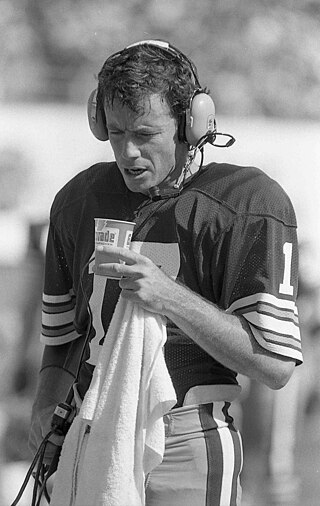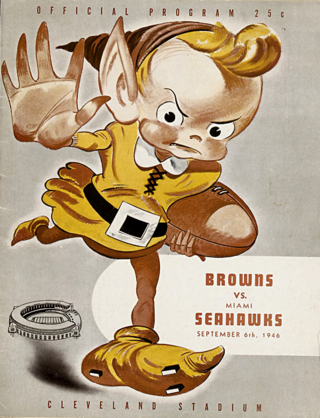Related Research Articles

Brian Winfield Sipe is an American former professional football player who was a quarterback for the Cleveland Browns of the National Football League (NFL) from 1974 to 1983. He then played in the United States Football League for two seasons.

The history of the Cleveland Browns American football team began in 1944 when taxi-cab magnate Arthur B. "Mickey" McBride secured a Cleveland, Ohio franchise in the newly formed All-America Football Conference (AAFC). Paul Brown, who coach Bill Walsh once called the "father of modern football", was the team's namesake and first coach. From the beginning of play in 1946 at Cleveland Municipal Stadium, the Cleveland Browns were a great success. Cleveland won each of the AAFC's four championship games before the league dissolved in 1949. The team then moved to the more established National Football League (NFL), where it continued to dominate. Between 1950 and 1955, Cleveland reached the NFL championship game every year, winning three times.
The 1990 Cleveland Browns season was the team's 41st season with the National Football League.
The 1994 Cleveland Browns season was the team's 45th season with the National Football League and 49th overall. It was the only season that the Browns qualified for the playoffs under head coach Bill Belichick. The Browns finished as the NFL's number one defense in terms of points surrendered per game. In the playoffs, Belichick got his first playoff victory as a head coach in the AFC wild card game against his eventual current team, the New England Patriots, 20–13. The Browns would lose to the Steelers 29–9 in the divisional round.
The 1981 Cleveland Browns season was the team's 32nd season with the National Football League. In a highly disappointing season filled with a number of key injuries at different stretches during the campaign, the Browns finished the year with five straight defeats, their longest losing streak since 1975, and dropped seven of their final eight games. By contrast, in 1980, the Browns enjoyed a five-game winning streak.
The 1982 Cleveland Browns season was the team's 33rd season with the National Football League.
The 1983 Cleveland Browns season was the team's 34th season with the National Football League.
The 1985 Cleveland Browns season was the team's 36th season with the National Football League.
The 1986 Cleveland Browns season was the team’s 37th season with the National Football League. The death of Don Rogers, a promising young defensive back who was preparing to enter his third season in the NFL, cast a black cloud over the team as it prepared for the 1986 season.
The 1970 Cleveland Browns season was the team's 21st season with the National Football League. The Browns attempted to improve on its 10-3-1 record from 1969. The team would fail to do so, and they finished with an even 7-7 record and missed the postseason. This was the first season that the Browns would play the Cincinnati Bengals, their new arch-rival in the AFC Central. The 2 teams split their 2 meetings in the first season series.
The 1972 Cleveland Browns season was the team's 23rd season with the National Football League.
The 1975 Cleveland Browns season was the team's 26th season with the National Football League. The Browns lost their first nine games—again, a team record—en route to going 3–11 in Forrest Gregg's first year as head coach after having been promoted from offensive line coach following the offseason firing of Nick Skorich.
The 1976 Cleveland Browns season was the franchise's 31st as a professional sports franchise and their 27th season as a member of the National Football League. The Browns were coached by second-year coach Forrest Gregg, and ended their season with a record of 9–5, being third in their division. The team's top draft choice was running back Mike Pruitt. Brian Sipe firmly took control at quarterback. Sipe had been inserted into the lineup after a Mike Phipps injury in the season-opening win against the New York Jets on September 12. After a 1–3 start brought visions of another disastrous year, the Browns jolted the two-time defending Super Bowl champion Pittsburgh Steelers with an 18–16 victory on October 10. Third-string quarterback Dave Mays helped lead the team to that victory, while defensive end Joe "Turkey" Jones' pile-driving sack of quarterback Terry Bradshaw fueled the heated rivalry between the two teams. That win was the first of eight in the next nine weeks, helping put the Browns in contention for the AFC playoffs. A loss to the Kansas City Chiefs in the regular-season finale cost them a share of the division title, but running back Greg Pruitt continued his outstanding play by rushing for exactly 1,000 yards, his second-straight four-digit season.
The 1977 Cleveland Browns season was the team's 28th season with the National Football League. After a 6-4 start, the Browns lost their final four games of the season, to finish with a disappointing 6-8 record. With one game left in the season, head coach Forrest Gregg was fired and replaced by Dick Modzelewski.
The 1978 Cleveland Browns season was the team's 29th season with the National Football League (NFL). After nearly three years of struggling offensively – and not making the playoffs—while posting just one winning record under ultra-strict, disciplinarian head coach Forrest Gregg, the Browns in 1978 decided to take a softer approach to liven up their attack – and their team. They did so by hiring a virtually unknown assistant at the time, New Orleans Saints receivers coach Sam Rutigliano, to replace Gregg, who was fired with one game left in the 1977 season. Rutigliano was the fourth head coach hired by Art Modell in his 18 years as club owner to that point, and it marked the first time Modell had not promoted from within the organization to fill the spot.
The 1979 Cleveland Browns season was the team's 30th season with the National Football League.
The 1980 Cleveland Browns season was the team's 35th overall, and 31st season in the National Football League. The Browns finished the regular season with eleven wins and five losses, and their first division title since 1971, winning a tiebreaker with the Houston Oilers. The 1980 Browns were known as the Kardiac Kids for having several games decided in the final moments. The 1980 season was the first time that Cleveland had qualified for the postseason since 1972. Also, for the second straight year, Browns head coach Sam Rutigliano was named NFL Coach of the Year, and quarterback Brian Sipe was named the league's Most Valuable Player.
The 1955 Cleveland Browns season was the team's sixth season with the National Football League. The Browns' defense became the first defense in the history of the NFL to lead the league in fewest points allowed and fewest total yards allowed for two consecutive seasons.
The 1966 Cleveland Browns season was the team's 17th season with the National Football League. They finished just 9–5, their worst record since 1962, and failed to make the playoffs for the first time since 1963.
The 1979 Buffalo Bills season was the franchise's 10th season in the National Football League, and 20th overall.
References
- ↑ The other was the 1956 team
- ↑ "1974 NFL Draft Listing – Pro-Football-Reference.com". Pro-Football-Reference.com . Archived from the original on 2009-05-31. Retrieved 2009-07-23.